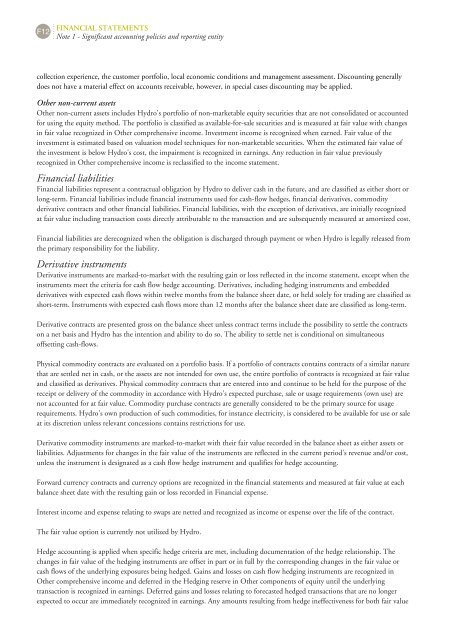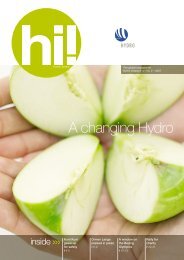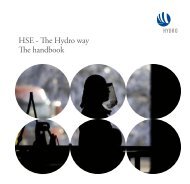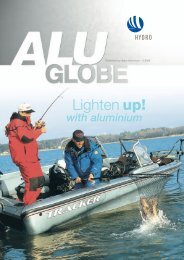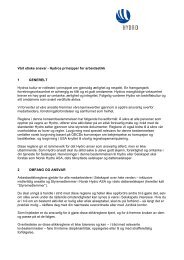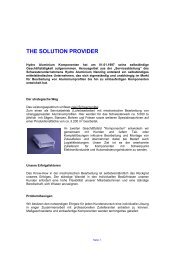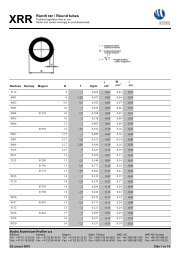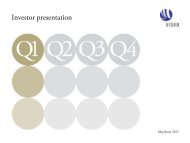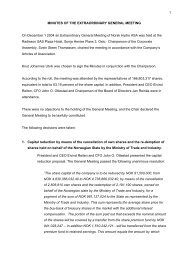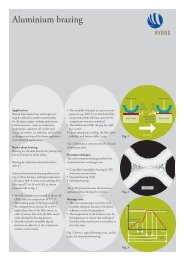Hydro Annual Report 2011b
Hydro Annual Report 2011b
Hydro Annual Report 2011b
Create successful ePaper yourself
Turn your PDF publications into a flip-book with our unique Google optimized e-Paper software.
F12<br />
FINANCIAL STATEMENTS<br />
Note 1 - Significant accounting policies and reporting entity<br />
collection experience, the customer portfolio, local economic conditions and management assessment. Discounting generally<br />
does not have a material effect on accounts receivable, however, in special cases discounting may be applied.<br />
Other non-current assets<br />
Other non-current assets includes <strong>Hydro</strong>'s portfolio of non-marketable equity securities that are not consolidated or accounted<br />
for using the equity method. The portfolio is classified as available-for-sale securities and is measured at fair value with changes<br />
in fair value recognized in Other comprehensive income. Investment income is recognized when earned. Fair value of the<br />
investment is estimated based on valuation model techniques for non-marketable securities. When the estimated fair value of<br />
the investment is below <strong>Hydro</strong>'s cost, the impairment is recognized in earnings. Any reduction in fair value previously<br />
recognized in Other comprehensive income is reclassified to the income statement.<br />
Financial liabilities<br />
Financial liabilities represent a contractual obligation by <strong>Hydro</strong> to deliver cash in the future, and are classified as either short or<br />
long-term. Financial liabilities include financial instruments used for cash-flow hedges, financial derivatives, commodity<br />
derivative contracts and other financial liabilities. Financial liabilities, with the exception of derivatives, are initially recognized<br />
at fair value including transaction costs directly attributable to the transaction and are subsequently measured at amortized cost.<br />
Financial liabilities are derecognized when the obligation is discharged through payment or when <strong>Hydro</strong> is legally released from<br />
the primary responsibility for the liability.<br />
Derivative instruments<br />
Derivative instruments are marked-to-market with the resulting gain or loss reflected in the income statement, except when the<br />
instruments meet the criteria for cash flow hedge accounting. Derivatives, including hedging instruments and embedded<br />
derivatives with expected cash flows within twelve months from the balance sheet date, or held solely for trading are classified as<br />
short-term. Instruments with expected cash flows more than 12 months after the balance sheet date are classified as long-term.<br />
Derivative contracts are presented gross on the balance sheet unless contract terms include the possibility to settle the contracts<br />
on a net basis and <strong>Hydro</strong> has the intention and ability to do so. The ability to settle net is conditional on simultaneous<br />
offsetting cash-flows.<br />
Physical commodity contracts are evaluated on a portfolio basis. If a portfolio of contracts contains contracts of a similar nature<br />
that are settled net in cash, or the assets are not intended for own use, the entire portfolio of contracts is recognized at fair value<br />
and classified as derivatives. Physical commodity contracts that are entered into and continue to be held for the purpose of the<br />
receipt or delivery of the commodity in accordance with <strong>Hydro</strong>'s expected purchase, sale or usage requirements (own use) are<br />
not accounted for at fair value. Commodity purchase contracts are generally considered to be the primary source for usage<br />
requirements. <strong>Hydro</strong>'s own production of such commodities, for instance electricity, is considered to be available for use or sale<br />
at its discretion unless relevant concessions contains restrictions for use.<br />
Derivative commodity instruments are marked-to-market with their fair value recorded in the balance sheet as either assets or<br />
liabilities. Adjustments for changes in the fair value of the instruments are reflected in the current period's revenue and/or cost,<br />
unless the instrument is designated as a cash flow hedge instrument and qualifies for hedge accounting.<br />
Forward currency contracts and currency options are recognized in the financial statements and measured at fair value at each<br />
balance sheet date with the resulting gain or loss recorded in Financial expense.<br />
Interest income and expense relating to swaps are netted and recognized as income or expense over the life of the contract.<br />
The fair value option is currently not utilized by <strong>Hydro</strong>.<br />
Hedge accounting is applied when specific hedge criteria are met, including documentation of the hedge relationship. The<br />
changes in fair value of the hedging instruments are offset in part or in full by the corresponding changes in the fair value or<br />
cash flows of the underlying exposures being hedged. Gains and losses on cash flow hedging instruments are recognized in<br />
Other comprehensive income and deferred in the Hedging reserve in Other components of equity until the underlying<br />
transaction is recognized in earnings. Deferred gains and losses relating to forecasted hedged transactions that are no longer<br />
expected to occur are immediately recognized in earnings. Any amounts resulting from hedge ineffectiveness for both fair value


